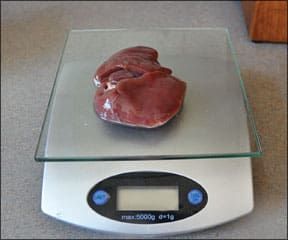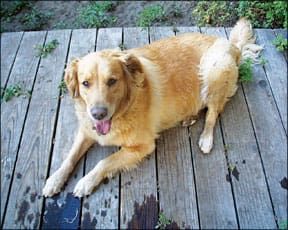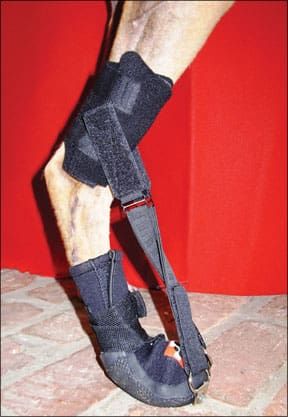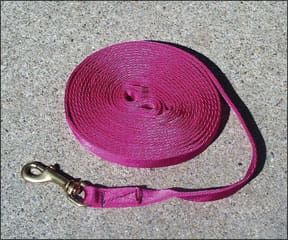Over the past few months, I’ve read more than 30 books on homemade diets for dogs. Many offered recipes that were dangerously incomplete; a smaller number provided acceptable guidelines but were confusing, unduly restrictive, overly complicated, or had other issues that made me recommend them only with reservations. A few were good enough to recommend without reservation.

This review is about the cream of the crop: three relatively new books (one is a new edition of an older book) whose authors have taken the time to analyze their recipes to ensure that they meet the latest nutritional guidelines established by the National Research Council (NRC). All three books offer boneless recipes as well as some that include raw meaty bones (RMBs), giving you the option of choosing either style of feeding, or a combination of the two, depending on what works best for both you and your dogs.
These three books take an approach that’s very different from the books that focus on just raw meaty bone diets, which I reviewed in December (“Reliable Guides for Raw Diets”). Those books provided dietary guidelines rather than recipes, relying on common sense and mimicking the evolutionary diet of the wolf rather than nutritional analyses to provide diets that are complete and balanced. I believe such an approach is valid and follow it myself, but the guidelines are often misinterpreted, leading to diets that are missing critical ingredients or overloaded with others, and thus nutritionally unbalanced and incomplete.
The books reviewed below also differ from the boneless diet books I reviewed in the January issue (“No Bones About It”): none of those books provided recipes that had been analyzed to ensure that they met NRC guidelines. The best of those books gave good guidelines for creating a complete homemade diet, but each required careful attention to the text to ensure that nothing was left out. People who just follow the recipes are likely to end up feeding an incomplete diet.
The three books included in this review are quite specific about what you should feed and what supplements you need to add. They offer peace of mind for those concerned that the diet they’re feeding may not meet all of their dog’s nutritional needs. They provide a reliable alternative for those who are not able to feed, for whatever reason, the wide variety of foods needed to provide a complete and balanced diet without supplementation. They offer help to people whose dogs are experiencing health problems that could be related to their diet. And for those of us who just want to understand more about where essential nutrients come from in the diets that we feed, and what might be missing, the information they provide is fascinating.
Two of these books provide recipes that meet requirements for all life stages, while the third can be used for adult maintenance only. It’s important to pay attention to this factor when you’re looking for books to help you feed your puppy or pregnant or nursing female.
I can’t recommend these books highly enough, not only for those interested in starting their dogs on a homemade diet, but also for people who already feed one. Reading through them has made me look more carefully at the diet I feed my own dog and the dietary guidelines that I give others, particularly regarding supplements. When I’m done with the book reviews, I plan to write about the changes I’m making based on what I’ve learned from these books.
A New Approach
Two books published fairly recently include recipes for both boneless and raw meaty bones (RMB) meals. These two books have similarities, as the authors have worked together in the past and relied on much of the same research. Both are particularly appropriate for those concerned that their homemade diets meet NRC guidelines, as all recipes have been designed and analyzed to ensure that they do.
These are the only homemade diet books that address the issue of balanced fats, going beyond the ratio of omega-6 to omega-3 fatty acids. Modifying fats may be beneficial for dogs with skin problems and other inflammatory conditions. Both books stress feeding lean meats, which they recommend feeding raw, but light cooking is acceptable for boneless meat. Both also advise using bone meal, or other supplements that combine calcium and phosphorus such as MCHC or dicalcium phosphate, rather than plain calcium to balance the boneless recipes. The extra phosphorus is needed to meet requirements for puppies, as the recipes are designed for all life stages.
Both books omit dairy products and grains (except for one recipe with a small amount of oat bran in Brown’s book), and limit the amount of starchy vegetables. This can be beneficial for some dogs, particularly those prone to weight gain or inflammation from health issues such as allergies and arthritis. Carbohydrates, however, reduce the cost of a homemade diet. Those with large dogs who do not feed RMBs (which are usually less expensive than muscle meats) may find these diets cost-prohibitive. Very active dogs and females used for breeding can also benefit from more carbohydrates in the diet.
Simple Yet Complete
Dr. Becker’s Real Food for Healthy Dogs & Cats is the perfect book for those who want simple, clear recipes that meet NRC and AAFCO requirements for both puppies and adult dogs. I loved the 2009 edition that I originally read, but I’ve also had a chance to preview the 3rd edition and it’s even better. The basic recipes are the same, but the new edition provides many more details, including nutritional analyses of all recipes. The authors still recommend feeding all of the foods in their original recipes, but the new edition offers options for omitting certain foods, telling you what additional supplements need to be provided in those cases.
Boneless recipes for beef, chicken, and turkey are included in both editions. The 2009 edition also has recipes for egg and sardine meals, with instructions that these can be spread out over a week rather than fed all at once. The new edition provides further details on how to integrate eggs and sardines into your weekly meal plan rather than feeding them separately. Along with the original recipes, the new edition also offers simplified versions that omit hearts and gizzards from the poultry recipes and allow you to use chicken liver with the turkey recipe, since it’s easier to find than turkey liver.
Recipes for meals that include chicken and turkey RMBs are provided as well. These recipes also include boneless meat and organs.
All recipes are 75 percent meat and organs, and 25 percent vegetables and fruits. Following the suggested rotation, the meat portion of the diet is about half poultry with the other half mostly beef, plus substantial quantities of eggs and sardines. In addition to muscle meat, some recipes also use liver and heart. No grains or dairy products are included in the diet. Two versions of each recipe are provided for making small or large batches, designed to feed a medium-sized dog for either one day or a week to 10 days.
In the 2009 edition, each meal includes its own veggie and fruit puree, while the new edition offers guidelines and three suggested recipes for putting together your own mixtures. There are separate sections for dogs and cats in the new edition, rather than combining the guidelines.
All recipes include a vitamin/mineral mix, essential fatty acids, and a “bone replacement supplement” such as bone meal for meals that don’t include RMBs. The new edition provides a range of calcium to give, since puppies require more calcium than adult dogs do (the 2009 edition just gives the higher amount that can be used for either puppies or adults). Detailed instructions are provided for putting together your own supplement mixture; additional supplementation options will be provided in the new edition, and the authors hope to offer a custom-made vitamin and mineral supplement designed to complement their recipes soon.
In the 2009 edition, krill oil is added to all meals, with additional flax oil in poultry meals and hemp oil in beef meals, to properly balance the fats. The new edition offers fish oil alternatives to krill oil, and has cut back on the need to add flax and hemp oils unless you are not able to feed both beef and poultry.
Clear guidelines are given for how much to feed adult dogs and puppies, and how to make the switch from commercial to homemade. Several chapters discuss specific types of foods and additives, including suggestions for substitutions in the recipes. Other topics covered include preparation, equipment, and storage; commercial treats; and commercial frozen foods. The new edition has added chapters on “Optimizing your pet’s diet” and “Side roads, pitfalls, and problems.”
While the supplements may seem daunting at first, these recipes are easy to follow once you have your supplies in place. I particularly like the homemade vitamin/mineral mix, which is easier to use than measuring out individual supplements each day, and helps ensure that all nutritional requirements are met.
In-Depth
For those who really want to understand the whys and wherefores of homemade diets, Unlocking the Canine Ancestral Diet is ideal. Author Steve Brown delves into the ancestral diet of the dog and compares it to the latest NRC guidelines. Brown is the creator of Steve’s Real Food for Dogs (he no longer owns the company) and See Spot Live Longer Homemade Dinner Mixes. Step by step, he investigates the nutrients supplied by different foods, and how to go about combining those foods to achieve balanced meals that meet NRC guidelines without the use of synthetic supplements (he adds vitamin E and also includes bone meal in recipes that don’t include bone). Particular attention is paid to ensuring that fats are properly balanced, going beyond the ratio of omega-6 to omega-3.

Brown provides one recipe for boneless beef, one for poultry that includes RMBs (chicken necks, whole or ground), and one that combines both. Other ingredients in the recipes include heart, liver, vegetables, fruits, sardines, eggs, oat bran, and oysters. Supplements include bone meal, hempseed oil, salt, kelp, chia or flaxseeds, vitamin E, and coconut oil.
Brown suggests rotating the recipes, using various ruminant meats (beef, lamb, bison, venison) for the first recipe, and different poultry meats (chicken, turkey, duck, pheasant) for the second. Substitutions for other ingredients are offered as well. Two variations of the combined recipe are offered for puppies and adult dogs; the others can be used for all life stages. Detailed feeding guidelines are provided for each recipe. Four additional low-fat recipes are also included in the appendices.
Brown does not include substitutions for the RMBs in his chicken and combination recipes. Since some people are reluctant to feed whole RMBs and may not have access to a grinder or pre-ground products, I asked him if it might be possible to feed these recipes without the chicken necks. He responded that they can be replaced with the same amount of boneless chicken thighs or breast with skin and fat removed, plus 1 ounce of human-grade bonemeal or comparable calcium/phosphorus supplement that provides about 8,000 milligrams of calcium (the next edition of his book will include this information).
For those looking for a quick and easy way to improve their dog’s nutrition and health without having to feed a homemade diet, Brown also offers what he calls an “ABC day,” meals to feed one day a week to dogs who otherwise eat commercial foods. These meals do not meet NRC guidelines, but are instead designed to complement and improve the diets of dogs fed dry food, canned food, or frozen raw foods. Two recipes are provided: one for dogs fed traditional high-carb dry food, and the other for dogs fed high-protein, high-fat dry, canned, or frozen raw food. Both recipes use beef hearts, sardines, eggs, vegetables, and fruits.
Additional chapters provide information on food storage; the effect on the body of protein, fat, and carbohydrates; and how to calculate the percentage of calories that come from each.
This book is more complex than many people want, though you can certainly use the recipes without following all the details about why each ingredient is used and exactly which nutrients it provides. Those of us who want to learn more about canine nutrition will find this book a real eye-opener. I refer to my copy frequently and find the information invaluable.
Raw or Cooked
Monica Segal’s book, K9 Kitchen, offers guidelines and sample recipes for diets based on raw meaty bones, cooked diets, and combinations of the two. Segal’s moderate approach encourages you to pick the style of feeding that you’re most comfortable with and that works for your dog. Sample weekly recipes for all three styles of feeding are included for dogs of various weights and activity levels.
Segal’s recipes use a variety of foods and supplements. Recommended foods include red meat, poultry, fish, organs, eggs, vegetables, fruits, and grains. Not discussed in the text but included in some of the recipes are dairy and legumes. Recommended RMBs include chicken necks, backs, wings, and carcasses; turkey necks and thighs; whole rabbit; and lamb rib.
Most weekly recipes contain between 7 and 14 ingredients, plus supplements. All recipes use kelp, zinc, and vitamin E; most use vitamin B compound and wild salmon oil; many use magnesium and manganese; and a few include cod liver oil, safflower oil, flaxseed oil, copper, multi-mineral complex, salt, and NoSalt. Calcium sources include calcium carbonate, ground eggshells, bone meal, and dicalcium phosphate.
This completely revamped 2nd edition of K9 Kitchen improves on the original in many ways. Gone are the frequent warnings about excess vitamin A and most of the overly precise recipe measurements. Recipe amounts are given in ounces rather than a mixture of ounces and grams. More sample recipes are provided, and all are weekly diet plans rather than daily recipes. Grams of protein, fat, and carbs are given rather than percentage of calories from each. On average, diets are higher in protein and lower in carbs.
Segal’s book contains a great deal of useful information, especially regarding dogs with diet-related health problems. It is a wonderful resource for those whose dogs have issues they suspect may be related to diet, including allergies, digestive upset, skin problems, and more. A chapter on stool problems and another on a variety of other health issues can help determine possible causes and dietary modifications to try.
My biggest concern with this book is that it makes things overly complicated for people with healthy dogs. Segal became interested in homemade diets thanks to her dog Zoey, a Cavalier King Charles Spaniel with a multitude of serious dietary issues. I suspect Segal’s impulse to control all aspects of Zoey’s diet resulted in her being overly concerned about details that are not an issue for healthy dogs (just as a parent with a chronically ill child might worry more about that child’s diet).
Segal makes many recommendations that I feel are unnecessary if your dog is healthy or has health issues unrelated to diet. For example, she says you must input any modifications to her recipes into a spreadsheet to ensure they meet NRC guidelines. NRC-recommended amounts for minerals must be matched exactly. She advises asking manufacturers for independent laboratory analyses of all supplements.
My feeling is that if this isn’t something you would do for yourself or your family, there’s no need to do it for your healthy dog. Substitutions of similar foods could be made without the need to create a spreadsheet, as long as the dog does not react negatively to the changes. NRC recommended amounts don’t need to be matched exactly any more than our own diets must be made to match recommended daily allowances of vitamins and minerals.
It should also be acceptable to substitute comparable calcium sources. Dicalcium phosphate and bone meal are similar. Ground eggshells are primarily calcium carbonate.
There’s no need to be quite as exact as these recipes specify. Measurements to the quarter of an ounce over a week’s time are unnecessarily precise. Recipes for dogs weighing 52 to 53 pounds can be used for dogs that weigh 50 or 55 pounds. Vitamin B amounts can be increased, if that makes it easier to give daily. Round supplement amounts as needed for convenience; you needn’t worry about giving exactly 56, 105, or 595 mg of magnesium, for example, just give 50, 100, or 600 mg.
Pay attention to the section “Before You Use a Diet Plan” when using these recipes. Wild salmon oil capsules in the recipes are 500 mg, so you will need to give half as many if using the more common 1,000 mg gelcaps. Eggshells must be ground to powder, not just crushed. The amount of calcium in bone meal varies considerably between products; adjust amounts accordingly if the bone meal you use has different amounts of calcium than the 667 mg per teaspoon used in these recipes.
Mary Straus investigates canine health and nutrition as an avocation. She is the owner of the DogAware.com website. She and her Norwich Terrier, Ella, live in the San Francisco Bay Area.
































